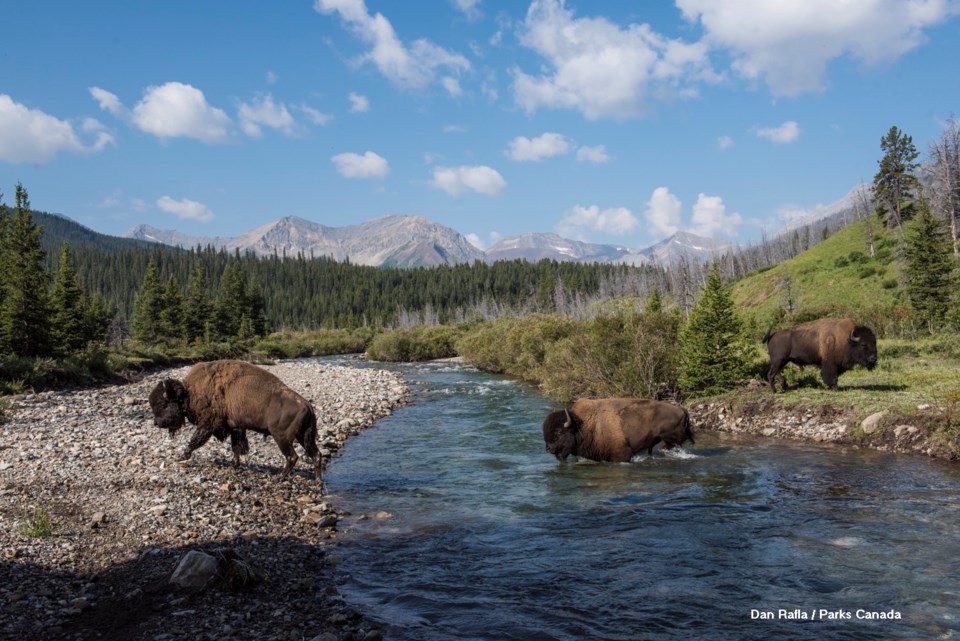PANTHER VALLEY – After just one week as truly wild animals, two bison bulls in Banff National Park’s reintroduction herd have headed for the hills.
Parks Canada confirmed Tuesday (Aug. 14) that two bison bulls have already left the 1,200 square kilometre reintroduction zone in the Panther Valley of Banff National Park to graze on land in the Province of Alberta.
Resource conservation manager Bill Hunt said the majority of the herd – 31 bison – have stayed within the reintroduction zone, but two bulls headed north to the Red Deer Valley and are roaming in and around the Ya Ha Tinda Ranch.
“We have been watching and monitoring their collars and telemetry and they are exploring the ranch area,” he said. “We are working closely with and updating the provincial government.”
A public campground near Ya Ha Tinda has warning signs up for campers indicating they may encounter a bison bull in the area. At this point, Hunt said, there are no plans to capture and move the bulls back, but if they range too far away or start to enter cattle grazing leases, that may occur.
“I think we are all quite happy the whole herd isn’t doing that; most have stayed within six kilometres of the release site,” he said. “These two seem fairly intent on exploring and that is typical behaviour of bulls. They want to understand the range and these animals have never been outside a fenced area before.”
The majority of the herd has remained within the reintroduction zone since being released on July 28, which project manager Karsten Heuer described as the best bison habitat available inside the national park.
“Almost half of that herd that has been released has already been born in Banff National Park and that is by design,” said Karsten Heuer. “This is a unique opportunity that Parks Canada has seized. We have a chunk of known historic plains bison range that is unoccupied where bison once were and we are bringing them back.”
Heuer said it is important to keep in mind these are wild animals that are now subject to natural processes on the landscape. It is the first time in their lives they are unfenced, as they arrived from Elk Island National Park in 2017, which is completely fenced and a lot smaller than the area they now have.
“We have great containment throughout most of the area through rock bridges and cliffs, but they are wild animals ultimately and there are always ways through and around,” Heuer said.
He said Parks Canada is prepared for this kind of situation and would work closely with the province, stakeholders and residents of the area to return them to the appropriate area.
“Those talks have been going really well and they have a fair bit of patience if they do go outside the park on provincial lands to give us time to try and move them back,” Heuer said. “I am really encouraged by how those conversations have progressed with the Province of Alberta over the last few years.”
The issue is in relation to the status of wild plains bison inside provincial jurisdiction. The current Wildlife Act does not specifically list them as a species that is protected because they have been extirpated for a significant time. The question many have asked, especially with Parks spending $6.4 million on the project, is what happens if one is shot and killed while outside the national park?
The provincial process to list a species under the act as protected requires a status assessment that is reviewed by the Endangered Species Conservation Committee. But for the past year, all boards, agencies and committees have been under review and as a result that work
was stalled.
Minister of Environment Shannon Phillips provided a statement to the Outlook about the reintroduction program for bison in the national park. She said while the iconic species is important to Albertans and Canadians, it also has fundamental cultural, material and spiritual importance to Indigenous peoples.
“Alberta Environment and Parks has worked with Banff National Park on the response plan for when bison move out of the national park and onto adjacent provincial lands,” stated Phillips. “In order to ensure the protection of this herd, we remain committed to signing a ministerial order to protect bison that temporarily range outside the park. The process of drafting this order is underway, but was recently delayed by a fire in an Environment and Parks office building that displaced some staff working on this order. We expect to sign this order before the end of the month.
“In the meantime, we’re calling on those that live, work and recreate near Banff National Park to help us identify when a bison is on provincial land and report it. We ask hunters to show restraint if and when they see bison on public lands. Bison are an important species to Albertans and Canadians, and as such, I ask Albertans to help us ensure the success of the reintroduction to Banff National Park.”
In preparation for the release, signage was installed in the area to educate the public on the possibility of bison encounters in the backcountry at trailheads and has ongoing communication with nearby residents.
Methods Parks has put in place to manage the bison’s movement includes adjustable fencing in strategic locations and a commitment to stockmanship or herding the animals by staff on horseback.
“It is tremendous,” Heuer said. “If you are in the right place at the right time to actually turn them, you can keep them calm and steer them around the landscape.”
Herd cows had calves in 2017, and again in 2018. Parks Canada confirmed two new calves have been born since the herd was released and as of Sunday (Aug. 5) the herd now totals 33 animals.




